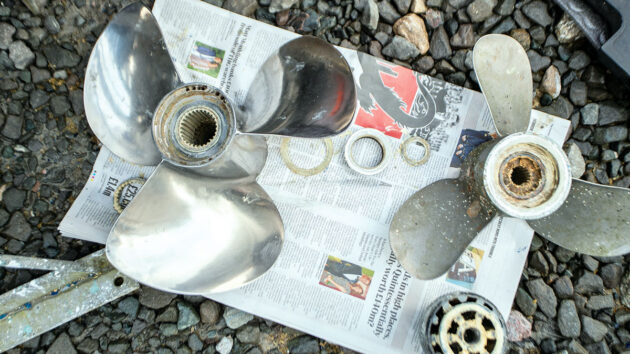Stu Davies has valuable tips on how to maintain your prop – and explains how this vital bit of kit works, and why propeller care is needed
The next time your boat is on the hard for a scrub, antifoul or whatever, have a look around and you will see quite a lot of different propellers on your neighbours’ boats.
Made of aluminium, brass or bronze – even plastic in the case of small outboards – some have two blades, some have three and some, very occasionally, have four.
While most have fixed blades some have blades that fold, but all need propeller care!
Propellers can be right-handed, where they turn clockwise as you go ahead, or left-handed where they turn anti-clockwise to go ahead.
Look from the stern to determine your rotation; mine is left-handed.
These differences come about because different types of propellers are suited to different types of boats, engines and transmissions.

The curved shape of the blades produces the thrust to drive the boat move through the water. Credit: Mike Maniatis/Shutterstock
How it works
How a propeller works is quite complex.
It transforms ‘torque’ from the engine into a linear motion.
A boat’s propeller is often referred to as a ‘screw’ but it is far from it.
It ‘screws’ its way through the water because the blades work similar to a wing on an aircraft and like a torque converter in a car’s automatic transmission; once it is up to speed it almost actually has a positive ‘grip’ on the water.
A turning propeller moves water behind the blades, almost like a hand grabbing water and pushing it behind it. This produces part of the thrust.
Each blade has a distinctive curved shape which, as it turns, acts like a foil in the process ‘pulling’ the propeller and the boat forward.
It acts like a foil because the angle of the blade creates lift as it moves through the water, in a similar way that a wing creates lift through the air, with a positive pressure, on the underside and a negative pressure, on the top side.
This produces the rest of the thrust.
Some power is wasted by the propeller causing ‘prop kick’, of which more later.
Going back to the ‘screw’ term. If a propeller was screwing its way through a solid material, the distance it would move in one revolution is equivalent to the propeller’s pitch.
In reality, because it is operating in a liquid, it doesn’t move far.
Diameter and pitch are the two dimensions given to describe a propeller and are usually marked on the hub.
Most of the propellers we encounter use inches as the measurement.
For example, on my boat, I have a three-bladed 16in x 16in bronze propeller fitted to a 30mm tapered and keyed shaft.

Prop kick can be used to your advantage, especially when reversing into a berth. Credit: Paul Wyeth
Why do props have different numbers of blades?
Two-bladed propellers are the best option for smaller sailing boats under 10m in length.
They give adequate performance under power and cause less drag when under sail.
Three-bladed propellers give greater thrust than two blades but increase drag.
Three-bladed props are more commonly used for power boats but larger sailing boats also use them.
Three-blades usually give a slightly better top speed performance than four blades.
Four-bladed propellers tend to be quieter and vibration free.
They produce more lift at the stern which can help with acceleration.

Four-bladed props are usually seen on larger boats
Folding props – extra propeller care is required for moving parts
Folding or feathering props are designed for sailing boats and minimise drag when the boat is under sail.
These are very effective but a lot more expensive than standard propellers.
Boat type, engine power, displacement and desired boat speed are all factored in when choosing the exact type and specification of a propeller.

Folding propellers have moving parts so using an appropriate antifoul is vital to keep fouling a bay. Credit: Ben Meakins/Future
Why use different metals to make props?
Most two-bladed props I have come across are fitted to saildrives and are made of aluminium.
They’re made of aluminium because of the need to keep copper-based materials away from the aluminium sail legs to avoid electrolytic corrosion.
This picture (below) of my friend’s two-bladed aluminium saildrive prop clearly shows galvanic corrosion as a result of electrolysis caused by the improper use of a copper-based antifoul on it and the saildrive leg.

The aluminium prop was initially power washed, which identified the galvanic corrosion. Credit: Stu Davies
Three-bladed props, such as mine, give greater thrust and prop kick.
Sometimes the prop kick is a nuisance but once the principle and action of it is understood it can be a big help when manoeuvring in reverse in tight quarters.
When going astern into my berth I turn the boat to starboard in reverse using the prop kick to help turn her.
My propeller is made of bronze and gives a dull dong when tapped instead of a ding like a bell.
It doesn’t have an anode on it either and has never shown any evidence of electrolysis.
Brass is another matter and, usually, small anodes are needed on the propeller and shaft to protect it.
Four-bladed props are rarely seen except on bigger motor yachts where they contribute to better acceleration; the extra surface area provides more surface area in the water.
Folding or feathering props are very effective, and are reputed to give up to one knot extra speed under sail due to their lower drag, but they are pricey compared to standard propellers.
Feathering or folding props also require a lot more attention and propeller care, given that they have bearing surfaces and gears and require periodic greasing.

Galvanic corrosion caused by using the incorrect antifoul on an aluminium propeller. Credit: Stu Davies
Propeller care and maintenance
Propellers use the curved side of the blade as an aerofoil-type surface.
If that smooth surface is disrupted by tube worms or barnacles then their efficiency is compromised.
It is, therefore important to keep the blades clean and smooth as part of your usual maintenance regime.
Every year I lift my boat in Portugal. The hull antifoul I use generally works well and there is usually just a touch of slime and a few tube worms on it after a year or so in the water.
These are easily cleaned off with a power wash.
However, the propeller is the bane of my life. Tube worms and limpets love my prop.
Over the years I’ve tried everything: polished it until it gleamed, covered it in lanolin, primed it and painted it with Hammerite then antifoul.
I have even used expensive cans of well-known antifoul propeller treatment but the beasties keep on coming, although using the expensive stuff does produce better results than highly polishing it.
I recommend polishing, priming and then slathering on the antifoul on a propeller for the best result.
Don’t forget that aluminium propellers and saildrives require specialist antifoul.
Always make sure you check and change the anodes and never cover the anodes with any product.
Folding propellers have moving parts, gear teeth and bearing surfaces, and need greasing as well.
Beasties can also get at the moving parts.
To check they are working, use them regularly and note any performance loss.
If this happens, anchor or moor in a suitable place, don a mask and snorkel and inspect them!
Every manufacturer will produce details about how to service your propeller and the interval between maintenance.
Always make sure you follow the instructions.

Tube worms even got behind the hub! Credit: Stu Davies

The prop after preliminary cleaning; note the primer and antifoul edges. Credit: Stu Davies
General rules on propellers
Whatever type of propeller you have, if you feel a vibration, make sure you get it checked out as it could be a problem with the propeller or an unbalanced shaft drive.
Always examine the prop blades for chips and corrosion and check they are not bent.
If you have taken the propeller off you can check its alignment by placing it on a flat surface and checking to see if all the blades touch the surface in the same place.
If you have a brass propeller, check for signs that it is turning a pinkish colour as this is an indication of dezincification which can cause the propeller to weaken and disintegrate.

he tips of this propeller have crumbled due to extensive dezincification. Credit: Duncan Kent
This is the main reason why an anode is so important.
If there are clear signs of the metal turning pink, you could try carefully polishing the propeller to see if the discolouration is removed and if the metal below is sound and not pitted or soft.
PBO’s survey and corrosion expert, Colin Brown, has this advice: “Use a wire brush or fine sandpaper with water.
“Be very careful about any dust you make and wear a mask while you work.
“If you get bright yellow metal you’re good to go but if the prop has suffered from serious dezincification, the metal will be dull in colour and in extreme cases it may well be soft enough that you can break bits off the blade edges with a thumbnail or a light hammer.
“The exposed metal faces would then be distinctly pink.
“With fixed propellers, a sharp tap on the blade with a small hammer should give a good ring when the prop is in good condition, and a dull sound if there is dezincification.
“This tends not to work so well on folding and feathering props but the metal should still sound hard.
“Don’t use a hammer too enthusiastically near the edge of a blade as you could damage it even if it’s sound.”
If you have any concerns about your propeller’s integrity, make sure you have it checked by a specialist.
Boat propeller: How to choose the right one for your boat
The correct prop can have a dramatic effect on your boat's performance. Ali Wood learns how you can save fuel,…
How to fit a folding propeller
Mark Ryan shares how he removed the old propeller on his Albin Ballad and replaced it with a two-bladed Flexofold…
Fouled propeller fix: top tips for solving the problem at sea
What should you do when you catch a line or fishing net and your prop becomes fouled? Ali Wood looks…
Want to read more practical articles?

A subscription to Practical Boat Owner magazine costs around 40% less than the cover price.
Print and digital editions are available through Magazines Direct – where you can also find the latest deals.
PBO is packed with information to help you get the most from boat ownership – whether sail or power.
-
-
-
- Take your DIY skills to the next level with trusted advice on boat maintenance and repairs
- Impartial in-depth gear reviews
- Practical cruising tips for making the most of your time afloat
-
-
Follow us on Facebook, Instagram, TikTok and Twitter







